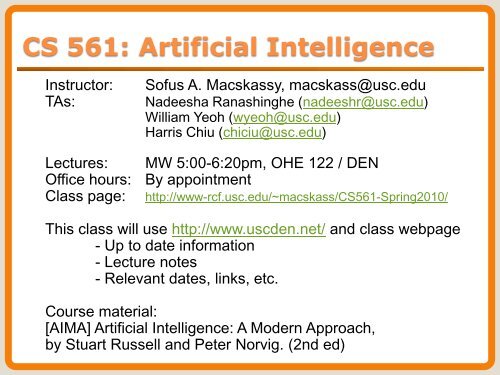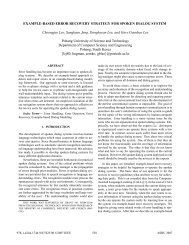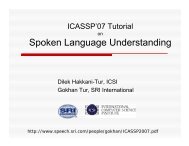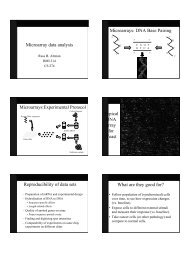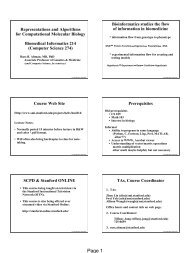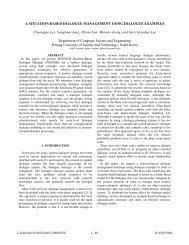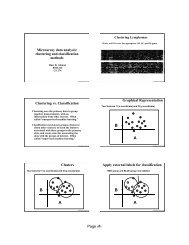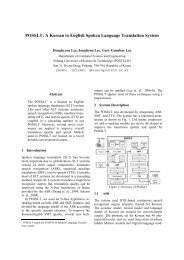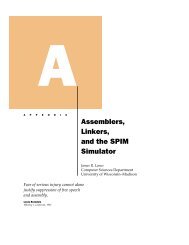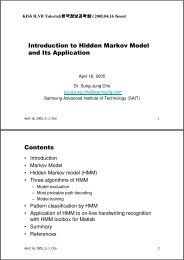CS 561: Artificial Intelligence - Usc
CS 561: Artificial Intelligence - Usc
CS 561: Artificial Intelligence - Usc
Create successful ePaper yourself
Turn your PDF publications into a flip-book with our unique Google optimized e-Paper software.
<strong>CS</strong> <strong>561</strong>: <strong>Artificial</strong> <strong>Intelligence</strong><br />
Instructor:<br />
TAs:<br />
Sofus A. Macskassy, macskass@usc.edu<br />
Nadeesha Ranashinghe (nadeeshr@usc.edu)<br />
William Yeoh (wyeoh@usc.edu)<br />
Harris Chiu (chiciu@usc.edu)<br />
Lectures: MW 5:00-6:20pm, OHE 122 / DEN<br />
Office hours: By appointment<br />
Class page: http://www-rcf.usc.edu/~macskass/<strong>CS</strong><strong>561</strong>-Spring2010/<br />
This class will use http://www.uscden.net/ and class webpage<br />
- Up to date information<br />
- Lecture notes<br />
- Relevant dates, links, etc.<br />
Course material:<br />
[AIMA] <strong>Artificial</strong> <strong>Intelligence</strong>: A Modern Approach,<br />
by Stuart Russell and Peter Norvig. (2nd ed)
Review<br />
• Intro<br />
• Intelligent agents<br />
• Problem solving and search<br />
• Adversarial game search<br />
• Constraint satisfaction problems<br />
• Logical agents<br />
• First-order logic<br />
• Knowledge representation<br />
• Logical reasoning<br />
• Planning<br />
• Uncertainty<br />
• Probabilistic reasoning and inference<br />
• Probabilistic reasoning over time<br />
• Rational decision-making<br />
• Learning<br />
• Communication and language<br />
<strong>CS</strong><strong>561</strong> - Lecture 26 - Macskassy - Spring 2010 2
Intro<br />
• Turing test<br />
• AI Research<br />
◦ Theoretical and experimental<br />
◦ Two lines<br />
• Biological – based on human analogy<br />
psychology/physiology<br />
• Phenomonal – formalizing common-sense<br />
• We have studied theoretical - phenomonal<br />
<strong>CS</strong><strong>561</strong> - Lecture 26 - Macskassy - Spring 2010 3
Intelligent agents<br />
• Intelligent agents<br />
◦ Anything that can be viewed as perceiving its<br />
environment through sensors and acting upon that<br />
environment through its actuators to maximize progress<br />
towards its goals<br />
◦ PAGE (Percepts, Actions, Goals, Environment)<br />
◦ The environment types largely determine the agent design<br />
◦ Described as a Perception (sequence) to Action Mapping:<br />
f : P* A<br />
◦ Using look-up-table, closed form, etc.<br />
• Agent Types: Reflex, state-based, goal-based, utility-based<br />
• Rational Action: The action that maximizes the expected<br />
value of the performance measure given the percept<br />
sequence to date<br />
<strong>CS</strong><strong>561</strong> - Lecture 26 - Macskassy - Spring 2010 4
Problem solving and search - uninformed<br />
• Uninformed<br />
• Breadth-first, Uniform-cost, Depth-first, Depth-limited, Iterative deepening<br />
• Problem formulation usually requires abstracting away realworld<br />
details to define a state space that can be explored<br />
using computer algorithms.<br />
◦ Single-state problem:<br />
◦ Multiple-state problem:<br />
◦ Contingency problem:<br />
◦ Exploration problem:<br />
deterministic, accessible<br />
deterministic, inaccessible<br />
nondeterministic, inaccessible<br />
unknown state space<br />
• Once problem is formulated in abstract form, complexity<br />
analysis helps us picking out best algorithm to solve problem.<br />
• Variety of uninformed search strategies; difference lies in<br />
method used to pick node that will be further expanded.<br />
• Iterative deepening search only uses linear space and not<br />
much more time than other uniformed search strategies.<br />
• Graph search can be exponentially more efficient than tree<br />
search.<br />
<strong>CS</strong><strong>561</strong> - Lecture 26 - Macskassy - Spring 2010 5
Problem solving and search - heuristic<br />
• Heuristic<br />
◦ Best first, A*, Hill-climbing, Simulated annealing<br />
• Time complexity of heuristic algorithms depend on quality of<br />
heuristic function. Good heuristics can sometimes be<br />
constructed by examining the problem definition or by<br />
generalizing from experience with the problem class.<br />
• Iterative improvement algorithms keep only a single state in<br />
memory.<br />
• Can get stuck in local extrema; simulated annealing provides<br />
a way to escape local extrema, and is complete and optimal<br />
given a slow enough cooling schedule.<br />
<strong>CS</strong><strong>561</strong> - Lecture 26 - Macskassy - Spring 2010 6
Adversarial game search<br />
• Game playing<br />
◦ Perfect play<br />
• The minimax algorithm, alpha-beta pruning<br />
◦ Elements of chance<br />
◦ Imperfect information<br />
• Complexity: many games have a huge search space<br />
◦ Chess: b = 35, m=100 nodes = 35 100<br />
if each node takes about 1 ns to explore<br />
then each move will take about 10 50 millennia<br />
to calculate.<br />
• Resource (e.g., time, memory) limit: optimal solution not<br />
feasible/possible, thus must approximate<br />
1. Pruning: makes the search more efficient by discarding<br />
portions of the search tree that cannot improve quality result.<br />
2. Evaluation functions: heuristics to evaluate utility of a state<br />
without exhaustive search<br />
<strong>CS</strong><strong>561</strong> - Lecture 26 - Macskassy - Spring 2010 7
Constraint satisfaction problems<br />
• <strong>CS</strong>Ps are a special kind of problem:<br />
◦ states defined by values of a fixed set of variables<br />
◦ goal test defined by constraints on variable values<br />
• Backtracking = depth-first search with one variable assigned per<br />
node<br />
• Variable ordering and value selection heuristics help significantly<br />
• Forward checking prevents assignments that guarantee later failure<br />
• Constraint propagation (e.g., arc consistency) does additional work<br />
• to constrain values and detect inconsistencies<br />
• The <strong>CS</strong>P representation allows analysis of problem structure<br />
• Tree-structured <strong>CS</strong>Ps can be solved in linear time<br />
• Iterative min-conflicts is usually effective in practice<br />
<strong>CS</strong><strong>561</strong> - Lecture 26 - Macskassy - Spring 2010 8
Logics in general<br />
Language Ontological Commitment Epistemological Commitment<br />
Propositional logic facts true/false/unknown<br />
First-order logic facts, objects, relations true/false/unknown<br />
Temporal logic facts, objects, relations, times true/false/unknown<br />
Probability logic facts degree of belief 0…1<br />
Fuzzy logic facts, degree of truth known interval value<br />
<strong>CS</strong><strong>561</strong> - Lecture 26 - Macskassy - Spring 2010 9
Logical agents – propositional logic<br />
• Logical agents apply inference to a knowledge base<br />
to derive new information and make decisions<br />
• Basic concepts of logic:<br />
◦ syntax: formal structure of sentences<br />
◦ semantics: truth of sentences wrt models<br />
◦ entailment: necessary truth of one sentence given another<br />
◦ inference: deriving sentences from other sentences<br />
◦ soundness: derivations produce only entailed sentences<br />
◦ completeness: derivations can produce all entailed sentences<br />
• Wumpus world requires the ability to represent partial and negated<br />
information, reason by cases, etc.<br />
• Forward, backward chaining are linear-time, complete for Horn<br />
clauses<br />
• Resolution is complete for propositional logic<br />
• Propositional logic lacks expressive power<br />
<strong>CS</strong><strong>561</strong> - Lecture 26 - Macskassy - Spring 2010 10
First-order logic<br />
• First-order logic:<br />
◦ objects and relations are semantic primitives<br />
◦ syntax: constants, functions, predicates, equality,<br />
quantifiers<br />
• Increased expressive power: sufficient to define<br />
wumpus world<br />
• Quantification – universal and existential<br />
• Situation calculus<br />
<strong>CS</strong><strong>561</strong> - Lecture 26 - Macskassy - Spring 2010 11
Inference in first-order logic<br />
• Reducing first-order inference to<br />
propositional inference<br />
• Unification<br />
• Generalized Modus Ponens<br />
• Forward and backward chaining<br />
• Logic programming<br />
• Resolution<br />
<strong>CS</strong><strong>561</strong> - Lecture 26 - Macskassy - Spring 2010 12
Knowledge representation<br />
• Knowledge engineering: principles and<br />
pitfalls<br />
• Ontologies<br />
• Examples<br />
<strong>CS</strong><strong>561</strong> - Lecture 26 - Macskassy - Spring 2010 13
Planning<br />
• Search vs. planning<br />
• STRIPS operators<br />
• Partial-order planning<br />
• Types of planners<br />
◦ Situation space planner: search through possible situations<br />
◦ Progression planner: start with initial state, apply operators until goal is<br />
reached<br />
◦ Regression planner: start from goal state and apply operators until start<br />
state reached<br />
◦ Partial order planner: some steps are ordered, some are not<br />
◦ Total order planner: all steps ordered (thus, plan is a simple list of steps)<br />
• Simple planning agent<br />
◦ Use percepts to build model of current world state<br />
◦ IDEAL-PLANNER: Given a goal, algorithm generates plan of action<br />
◦ STATE-DESCRIPTION: given percept, return initial state description in<br />
format required by planner<br />
◦ MAKE-GOAL-QUERY: used to ask KB what next goal should be<br />
<strong>CS</strong><strong>561</strong> - Lecture 26 - Macskassy - Spring 2010 14
Uncertainty<br />
• Probability is a rigorous formalism for<br />
uncertain knowledge<br />
• Joint probability distribution specifies<br />
probability of every atomic event<br />
• Queries can be answered by summing over<br />
atomic events<br />
• For nontrivial domains, we must find a way<br />
to reduce the joint size<br />
• Independence and conditional independence<br />
provide the tools<br />
<strong>CS</strong><strong>561</strong> - Lecture 26 - Macskassy - Spring 2010 15
Probabilistic reasoning<br />
• Syntax and Semantics<br />
• Parameterized distributions<br />
• Bayes nets provide a natural representation<br />
for (causally induced) conditional<br />
independence<br />
• Topology + CPTs = compact representation<br />
of joint distribution<br />
• Canonical distributions (e.g., noisy-OR) =<br />
compact representation of CPTs<br />
• Continuous variables ) parameterized<br />
distributions (e.g., linear Gaussian)<br />
<strong>CS</strong><strong>561</strong> - Lecture 26 - Macskassy - Spring 2010 16
Probabilistic inference<br />
• Exact inference by variable elimination<br />
◦ polytime on polytrees, NP-hard on general graphs<br />
◦ space = time, very sensitive to topology<br />
• Approximate inference by LW, MCMC:<br />
◦ LW does poorly when there is lots of<br />
(downstream) evidence<br />
◦ LW, MCMC generally insensitive to topology<br />
◦ Convergence can be very slow with probabilities<br />
close to 1 or 0<br />
◦ Can handle arbitrary combinations of discrete and<br />
continuous variables<br />
<strong>CS</strong><strong>561</strong> - Lecture 26 - Macskassy - Spring 2010 17
Probabilistic reasoning over time<br />
• Temporal models use state & sensor variables replicated over time<br />
• Markov assumptions and stationarity assumption, so we need<br />
- transition modelP(XtjXt-1)<br />
- sensor model P(EtjXt)<br />
• Tasks are filtering, prediction, smoothing, most likely sequence;<br />
all done recursively with constant cost per time step<br />
• Hidden Markov models have a single discrete state variable<br />
• Dynamic Bayes nets subsume HMMs, Kalman filters; exact update<br />
intractable<br />
• Particle filtering is a good approximate filtering algorithm for DBNs<br />
<strong>CS</strong><strong>561</strong> - Lecture 26 - Macskassy - Spring 2010 18
Rational decision-making<br />
• Rational preferences<br />
• Utilities<br />
• Money<br />
• Multi-attribute utilities<br />
• Decision networks<br />
• Value of information<br />
<strong>CS</strong><strong>561</strong> - Lecture 26 - Macskassy - Spring 2010 19
Learning<br />
• Learning needed for unknown environments, lazy designers<br />
• Learning agent = performance element + learning element<br />
• Learning method depends on type of performance element, available<br />
• feedback, type of component to be improved, and its representation<br />
• For supervised learning, the aim is to nd a simple hypothesis<br />
• that is approximately consistent with training examples<br />
• Decision tree learning using information gain<br />
• Learning performance = prediction accuracy measured on test set<br />
<strong>CS</strong><strong>561</strong> - Lecture 26 - Macskassy - Spring 2010 20
Statistical Learning<br />
• Bayes learning<br />
◦ Full Bayesian learning gives best possible predictions but is intractable<br />
◦ MAP learning balances complexity with accuracy on training data<br />
◦ Maximum likelihood assumes uniform prior, OK for large data sets<br />
• Choose a parameterized family of models to describe the data<br />
• Search for model parameters which best fit the data<br />
• Neural nets<br />
◦ Most brains have lots of neurons; each neuron linear-threshold unit<br />
◦ Perceptrons (one-layer networks) insufficiently expressive<br />
◦ Multi-layer networks are sufficiently expressive; can be trained by<br />
gradient descent, i.e., error back-propagation<br />
◦ Many applications: speech, driving, handwriting, fraud detection, etc.<br />
◦ Engineering, cognitive modelling, and neural system modelling<br />
subfields have largely diverged<br />
<strong>CS</strong><strong>561</strong> - Lecture 26 - Macskassy - Spring 2010 21
Communication and language<br />
• Communication<br />
• Grammar<br />
• Syntactic analysis<br />
• Problems<br />
<strong>CS</strong><strong>561</strong> - Lecture 26 - Macskassy - Spring 2010 22


